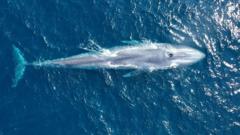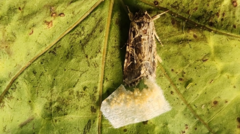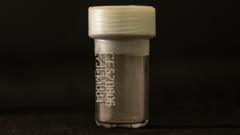In Timor-Leste, local fishermen and marine ecologists collaborate to monitor pygmy blue whales, uncovering unique behaviours and boosting tourism while fostering marine conservation awareness.
Local Eyes on the Ocean: Citizen Scientists Reveal Blue Whales' Habitat Secrets

Local Eyes on the Ocean: Citizen Scientists Reveal Blue Whales' Habitat Secrets
An inspiring story of citizen scientists in Timor-Leste who are uncovering invaluable insights about pygmy blue whales through innovative methods and community involvement.
For two months each year, Faustino Mauloko da Cunha and his son Zacarias devote their days to searching for pygmy blue whales off the coast of Timor-Leste. With binoculars and a telephoto camera in hand, the duo keeps a watchful eye over the Pacific waters, ready to spring into action when a whale surfaces. Their efforts are supported by a team led by Australian marine ecologist Prof. Karen Edyvane, who utilizes drones to capture images of these majestic creatures.
This grassroots initiative, based in the local village of Subaun, has yielded an impressive finding: nearly 3,000 pygmy blue whale sightings over the last decade. Given the elusive nature of these giants, this achievement is nothing short of remarkable.
The maritime region boasts one of the highest concentrations of marine mammals globally, with pygmy blue whales migrating from southern Australia to the Banda Sea during October and November. Prof Edyvane initiated this monitoring program in 2014, seeking to fill the research gaps surrounding these whales. She collaborates with locals, including fishermen, students, and dive tour operators, to learn more about blue whale behaviours, capturing moments like a mother nursing her calf—previously almost entirely undocumented.
The project started digitally via a Facebook group that called for volunteers to help spot and study whale activity. Consequently, local fishermen's sightings are frequently updated on social media, generating excitement and engagement within the community. In 2016, they even launched their first whale-watching tour with the help of local dive operators.
In a humble but essential development, the team established a research station at the da Cunha family home. Equipped with basic facilities, the station allows for round-the-clock monitoring, increasing the chances of capturing rare footage of whale behaviour. According to Prof Edyvane, they are even close enough to hear the whales’ blows.
Wildlife scientist Vanessa Pirotta commended citizen scientists for becoming invaluable partners in marine research, highlighting the role of technology and social media in facilitating real-time observations.
As whale conservation efforts gain traction, local tourism has surged, with whale-watching tours often booked years in advance. While this increase brings challenges, including potential threats from unregulated tourism, the government has committed to using Prof Edyvane's research to safeguard marine life in Timor-Leste.
Whale tourism, with appropriate regulations, presents economic opportunities for Subaun, where many residents earn less than $1,000 annually. The da Cunha family has begun offering meals made from local ingredients to visiting students and tourists, adding another stream of income. Faustino expressed enthusiasm about welcoming guests and creating memorable experiences in the future.
Zacarias has even begun providing drone services for whale monitoring, while Prof Edyvane plans to offer him training to share his knowledge about whales in English with tourists. He embraces the educational aspects of the project and the locals' role in teaching visitors about whale protection, emphasizing the importance of observing these creatures from a distance without interference.
Timor-Leste stands as an inspiring example of how community collaboration and scientific engagement can illuminate the wonders of the ocean while fostering stewardship for the environment.























